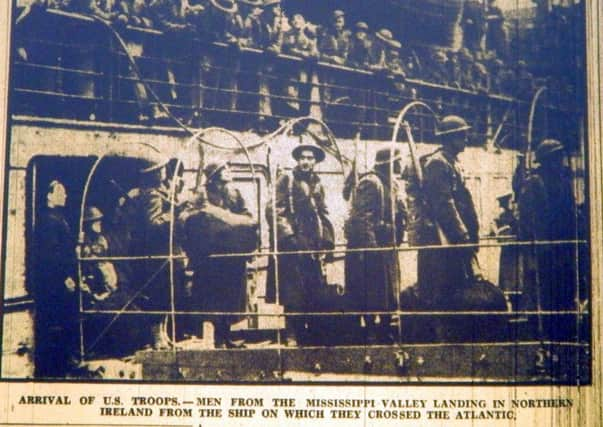GIs, Baseball and Jitterbug: the talk of east Antrim area 75 years ago!


The entry of the United States into the Second World War following the attack on Pearl Harbour in December 1941 saw the arrival of the first GIs in January 1942.
Some 3,600 men of the Vth Army arrived to be welcomed by the band of the Royal Ulster Rifles playing the Star Spangled Banner on the quayside in Belfast.
Advertisement
Hide AdAdvertisement
Hide AdAt the end of February another large contingent of troops arrived, this time to less fanfare and publicity.
And seventy five years ago this month Carrickfergus was one of the first towns welcoming young men from America to these shores.
On Thursday, February 5th, one of the first official events to welcome the GIs took place in Carrickfergus town hall, when a concert, tea and dance was held.
Local artists taking part in the event included Mount Saint Nicholas Dancing team and the Reparatory Players while the chairman of the Council, W. McCullough, welcomed the Americans to the town.
Advertisement
Hide AdAdvertisement
Hide AdIn reply an American officer said the troops had already been made to feel at home in Northern Ireland.
A young man named Bill Adamson gave a spirited rendition of the Star Spangled Banner, an article in the Larne Times and Weekly Telegraph reported.
Carrick would be home to troops based at Sunnylands and elsewhere, while at Woodburn the spectacle of baseball would soon become common, with Easter Monday 1942 being the first occasion that the sport was played in the town, two US Army teams showing locals the rules of the game.
A second match a few weeks later was held in aid of war charities and attracted similar crowds of locals, while the visit of the General Officer Commanding the American forces in Northern Ireland, Major-General R. P. Hartle added to the occasion.
Advertisement
Hide AdAdvertisement
Hide AdA further match was organised a few weeks later at Dixon Park in Ballyclare, and was just one visual aspect of the American presence.
Ulster served as a major bridgehead for the Americans: the first troops stepped ashore on January 23, 1942 and by late that year troop numbers reached almost 37,000, this being prior to their participation in Operation Torch against the Axis forces in North Africa and Italy.
At Carrickfergus a special commando regiment, the US Rangers, was raised in June 1942 and reached a complement of just under 600 men.
In June 1944, just prior to the Normandy Landings, the US military population in Northern Ireland had reached over 120,000, a figure which represented almost one tenth of the total indigenous population from the 1937 census. In Fermanagh, where the 8th infantry was deployed, it was nearer to one fifth the ratio.
Advertisement
Hide AdAdvertisement
Hide AdThe American presence led to development of an infrastructure including airfields, bases and construction of a new town at Langford Lodge, which served as a repair depot for the Lockheed Overseas Corporation and became USAF Base 597 employing 2,200 civilian personnel and having a population of 6,000 at its peak.
By February 1942 a report by the Garda in the Irish Free State described Londonderry as like an American port, and it had the facility to cope with 149 ships including 30 destroyers at its peak in April 1943. Until August 1944 the bulk of personnel were American.
Not all GIs were impressed with Londonderry, however, with one referring to the city as being ‘like a cemetery with lights’ in correspondence home.
Many of the soldiers were aware of family connections, and one of them, William Bunting, was featured in the Larne Times of May 7, 1942, as having managed to track down an uncle in Ballyeaston whose surname was Finlay and other relatives in Whitehead and elsewhere.
Advertisement
Hide AdAdvertisement
Hide AdAmong those who landed was 21 year old Silas Johnston from South Dakota, who was a Sioux Indian, while newspapers reported that there were many Irish-Americans and men of Scandinavian descent among the new arrivals.
The average age of the first GIs who arrived here 75 years ago was 26 years old, and the average private earned $50 a month, with sergeants pay double that amount.
Some of the first batch of soldiers were from farming backgrounds but they found Ulster farms out of date compared to home. One soldier said the farms were “about a century behind the times” while others remarked on the hedgerows which kept field sizes much smaller than in the Mid-West of the US.
If the arrival of coloured troops was a culture shock to Northern Ireland people at that time, there was little sign of it; there were racial tensions within the US military during that period, but one coloured soldier would write of how well he and his colleagues were treated in Carrickfergus.
Advertisement
Hide AdAdvertisement
Hide AdIn more general terms the soldiers had not known what to expect, and were given a special booklet to introduce them to Northern Ireland.
Key points which were stressed included not to cross the Irish border since the Irish Free State was a neutral country, and not to discuss religion or politics with Northern Ireland people.
At least one of those who landed 75 years ago would have had no concept of anything quite as complicated: one of the soldiers brought a mascot, a mongrel dog named Jitterbug, across the Atlantic.
It had been a long journey of 3,000 miles to get here, but a warm welcome awaited the Vth army, men and dog.